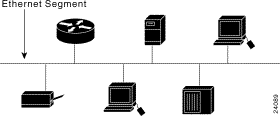
The term Ethernet refers to the family of local area network (LAN) implementations that includes three principal categories.
Ethernet has survived as an essential media technology because of its tremendous flexibility and its relative simplicity to implement and understand. Although other technologies have been touted as likely replacements, network managers have turned to Ethernet and its derivatives as effective solutions for a range of campus implementation requirements. To resolve Ethernet's limitations, innovators (and standards bodies) have created progressively larger Ethernet pipes. Critics might dismiss Ethernet as a technology that cannot scale, but its underlying transmission scheme continues to be one of the principal means of transporting data for contemporary campus applications.
Ethernet is a baseband LAN specification invented by Xerox Corporation that operates at 10 Mbps using carrier sense multiple access collision detect (CSMA/CD) to run over coaxial cable. Ethernet was created by Xerox in the 1970s, but the term is now often used to refer to all CSMA/CD LANs. Ethernet was designed to serve in networks with sporadic, occasionally heavy traffic requirements, and the IEEE 802.3 specification was developed in 1980 based on the original Ethernet technology. Ethernet Version 2.0 was jointly developed by Digital Equipment Corporation, Intel Corporation, and Xerox Corporation. It is compatible with IEEE 802.3. The figure below illustrates an Ethernet network.
Ethernet and IEEE 802.3 are usually implemented in either an interface card or in circuitry on a primary circuit board. Ethernet cabling conventions specify the use of a transceiver to attach a cable to the physical network medium. The transceiver performs many of the physical-layer functions, including collision detection. The transceiver cable connects end stations to a transceiver.
IEEE 802.3 provides for a variety of cabling options, one of which is a specification referred to as 10Base5. This specification is the closest to Ethernet. The connecting cable is referred to as an attachment unit interface (AUI), and the network attachment device is called a media attachment unit (MAU), instead of a transceiver.
An Ethernet network runs CSMA/CD over coaxial cable.

In Ethernet's broadcast-based environment, all stations see all frames placed on the network. Following any transmission, each station must examine every frame to determine whether that station is a destination. Frames identified as intended for a given station are passed to a higher-layer protocol.
Under the Ethernet CSMA/CD media-access process, any station on a CSMA/CD LAN can access the network at any time. Before sending data, CSMA/CD stations listen for traffic on the network. A station wanting to send data waits until it detects no traffic before it transmits.
As a contention-based environment, Ethernet allows any station on the network to transmit whenever the network is quiet. A collision occurs when two stations listen for traffic, hear none, and then transmit simultaneously. In this situation, both transmissions are damaged, and the stations must retransmit at some later time. Back-off algorithms determine when the colliding stations should retransmit.
Although Ethernet and IEEE 802.3 are quite similar in many respects, certain service differences distinguish the two specifications. Ethernet provides services corresponding to Layers 1 and 2 of the OSI reference model, and IEEE 802.3 specifies the physical layer (Layer 1) and the channel-access portion of the link layer (Layer 2). In addition, IEEE 802.3 does not define a logical link-control protocol but does specify several different physical layers, whereas Ethernet defines only one. The figure belowillustrates the relationship of Ethernet and IEEE 802.3 to the general OSI reference model.
Ethernet and the IEEE 802.3 OSI reference model.
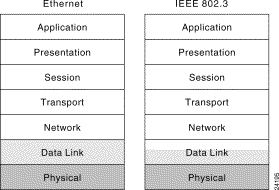
Each IEEE 802.3 physical-layer protocol has a three-part name that summarizes its characteristics. The components specified in the naming convention correspond to LAN speed, signaling method, and physical media type. The figure below illustrates how the naming convention is used to depict these components.
IEEE 802.3 components are named according to conventions.
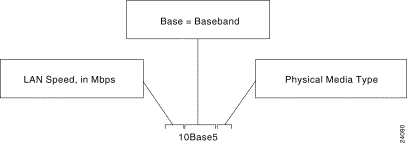
The following table summarizes the differences between Ethernet and IEEE 802.3, as well as the differences between the various IEEE 802.3 physical-layer specifications.
Table Comparison of Various IEEE 802.3 Physical-Layer Specifications
| Characteristic | Ethernet Value | IEEE 802.3 Values | ||||
|---|---|---|---|---|---|---|
| 10Base5 | 10Base2 | 10BaseT | 10BaseFL | 100BaseT | ||
| Data rate (Mbps) | 10 | 10 | 10 | 10 | 10 | 100 |
| Signaling method | Baseband | Baseband | Baseband | Baseband | Baseband | Baseband |
| Maximum segment length (m) | 500 | 500 | 185 | 100 | 2,000 | 100 |
| Media | 50-ohm coax (thick) | 50-ohm coax (thick) | 50-ohm coax (thin) | Unshielded twisted-pair cable | Fiber-optic | Unshielded twisted-pair cable |
| Topology | Bus | Bus | Bus | Star | Point-to-point | Bus |
The following diagram illustrates the frame fields associated with both Ethernet and IEEE 802.3 frames.
Various frame fields exist for both Ethernet and IEEE 802.3.

The Ethernet and IEEE 802.3 frame fields illustrated are as follows.
100-Mbps Ethernet is a high-speed LAN technology that offers increased bandwidth to desktop users in the wiring center, as well as to servers and server clusters (sometimes called server farms) in data centers.
The IEEE Higher Speed Ethernet Study Group was formed to assess the feasibility of running Ethernet at speeds of 100 Mbps. The Study Group established several objectives for this new higher-speed Ethernet but disagreed on the access method. At issue was whether this new faster Ethernet would support CSMA/CD to access the network medium or some other access method.
The study group divided into two camps over this access-method disagreement: the Fast Ethernet Alliance and the 100VG-AnyLAN Forum. Each group produced a specification for running Ethernet (and Token Ring for the latter specification) at higher speeds: 100BaseT and 100VG-AnyLAN, respectively.
100BaseT is the IEEE specification for the 100-Mbps Ethernet implementation over unshielded twisted-pair UTP) and shielded twisted-pair (STP) cabling. The Media Access Control (MAC) layer is compatible with the IEEE 802.3 MAC layer. Grand Junction, now a part of Cisco Systems Workgroup Business Unit (WBU), developed Fast Ethernet, which was standardized by the IEEE in the 802.3u specification.
100VG-AnyLAN is an IEEE specification for 100-Mbps Token Ring and Ethernet implementations over 4-pair UTP. The MAC layer is not compatible with the IEEE 802.3 MAC layer. 100VG-AnyLAN was developed by Hewlett-Packard (HP) to support newer time-sensitive applications, such as multimedia. A version of HP's implementation is standardized in the IEEE 802.12 specification.
100BaseT uses the existing IEEE 802.3 CSMA/CD specification. As a result, 100BaseT retains the IEEE 802.3 frame format, size, and error-detection mechanism. In addition, it supports all applications and networking software currently running on 802.3 networks. 100BaseT supports dual speeds of 10 and 100 Mbps using 100BaseT fast link pulses (FLPs). 100BaseT hubs must detect dual speeds much like Token Ring 4/16 hubs, but adapter cards can support 10 Mbps, 100 Mbps, or both.
Components used for a 100BaseT physical connection include the following:
The diagram below depicts the 100BaseT hardware components.
100BaseT requires several hardware components.

100BaseT and 10BaseT use the same IEEE 802.3 MAC access and collision detection methods, and they also have the same frame format and length requirements. The main difference between 100BaseT and 10BaseT (other than the obvious speed differential) is the network diameter. The 100BaseT maximum network diameter is 205 meters, which is approximately 10 times less than 10-Mbps Ethernet.
Reducing the 100BaseT network diameter is necessary because 100BaseT uses the same collision-detection mechanism as 10BaseT. With 10BaseT, distance limitations are defined so that a station knows while transmitting the smallest legal frame size (64 bytes) that a collision has taken place with another sending station that is located at the farthest point of the domain.
To achieve the increased throughput of 100BaseT, the size of the collision domain had to shrink. This is because the propagation speed of the medium has not changed, so a station transmitting 10 times faster must have a maximum distance that is 10 times less. As a result, any station knows within the first 64 bytes whether a collision has occurred with any other station.
100BaseT supports three media types at the OSI physical layer (Layer 1): 100BaseTX, 100BaseFX, and 100BaseT4.
100BaseTX100BaseTX is based on the American National Standards Institutes (ANSI) Twisted Pair-Physical Medium Dependent (TP-PMD) specification. The ANSI TP-PMD supports UTP and STP cabling. 100BaseTX uses the 100BaseX signaling scheme over 2-pair Category 5 UTP or STP.
100BaseFX is based on the ANSI TP-PMD X3T9.5 specification for FDDI LANs. 100BaseFX uses the 100BaseX signaling scheme over two-strand multimode fiber-optic (MMF) cable. The IEEE 802.3u specification for 100BaseFX networks allows data terminal equipment (DTE)-to-DTE links of approximately 400 meters, or one repeater network of approximately 300 meters in length.
100BaseT4 allows 100BaseT to run over existing Category 3 wiring, provided that all four pairs of cabling are installed to the desktop. 100BaseT4 uses the half-duplex 4T+ signaling scheme. The IEEE 802.3u specification for 100BaseT4 networks allows a maximum of two repeater (hub) networks and a total network diameter of approximately 200 meters. A link segment, which is defined as a point-to-point connection between two MII devices, can be up to 100 meters.
100VG-AnyLAN was developed by HP as an alternative to CSMA/CD for newer time-sensitive applications, such as multimedia. The access method is based on station demand and was designed as an upgrade path from Ethernet and 16-Mbps Token Ring. 100VG-AnyLAN supports the following cable types:
The IEEE 802.12 100VG-AnyLAN standard specifies the link-distance limitations, hub-configuration limitations, and maximum network-distance limitations. Link distances from node to hub are 100 meters (Category 3 UTP) or 150 meters.
100VG-AnyLA link-distance limitations differ for Category 3 and 5 UTP links.
100VG-Any LAN hubs are arranged in a hierarchical fashion. Each hub has at least one uplink port, and every other port can be a downlink port. Hubs can be cascaded three-deep if uplinked to other hubs, and cascaded hubs can be 100 meters apart (Category 3 UTP) or 150 meters apart (Category 5 UTP).
End-to-end network-distance limitations are 600 meters (Category 3 UTP) or 900 meters (Category 5 UTP). If hubs are located in the same wiring closet, end-to-end distances shrink to 200 meters (Category 3 UTP) and 300 meters (Category 5 UTP).
100VG-AnyLAN uses a demand-priority access method that eliminates collisions and can be more heavily loaded than 100BaseT. The demand-priority access method is more deterministic than CSMA/CD because the hub controls access to the network.
The 100VG-AnyLAN standard calls for a level-one hub, or repeater, that acts as the root. This root repeater controls the operation of the priority domain. Hubs can be cascaded three-deep in a star topology. Interconnected hubs act as a single large repeater, with the root repeater polling each port in port order.
In general, under 100VG-AnyLAN demand-priority operation, a node wanting to transmit signals its request to the hub (or switch). If the network is idle, the hub immediately acknowledges the request and the node begins transmitting a packet to the hub. If more than one request is received at the same time, the hub uses a round-robin technique to acknowledge each request in turn. High-priority requests, such as time-sensitive videoconferencing applications, are serviced ahead of normal-priority requests. To ensure fairness to all stations, a hub does not grant priority access to a port more than twice in a row.
Gigabit Ethernet is an extension of the IEEE 802.3 Ethernet standard. Gigabit Ethernet builds on the Ethernet protocol but increases speed tenfold over Fast Ethernet, to 1000 Mbps, or 1 Gbps. This MAC and PHY standard promises to be a dominant player in high-speed LAN backbones and server connectivity. Because Gigabit Ethernet significantly leverages on Ethernet, network managers will be able to leverage their existing knowledge base to manage and maintain Gigabit Ethernet networks.
To accelerate speeds from 100-Mbps Fast Ethernet to 1 Gbps, several changes need to be made to the physical interface. It has been decided that Gigabit Ethernet will look identical to Ethernet from the data link layer upward. The challenges involved in accelerating to 1 Gbps have been resolved by merging two technologies: IEEE 802.3 Ethernet and ANSI X3T11 Fibre Channel. The figure below shows how key components from each technology have been leveraged to form Gigabit Ethernet.
The Gigabit Ethernet protocol stack was developed from a combination of the Fibre Channel and IEEE 802.3 protocol stacks.
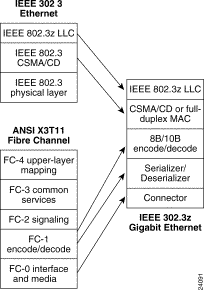
Leveraging these two technologies means that the standard can take advantage of the existing high-speed physical interface technology of Fibre Channel while maintaining the IEEE 802.3 Ethernet frame format, backward compatibility for installed media, and use of full-or half-duplex (via CSMA/CD).
The Gigabit Ethernet specification addresses three forms of transmission media: long-wave (LW) laser over single-mode and multimode fiber (to be known as 1000BaseLX), short-wave (SW) laser over multimode fiber (to be known as 1000BaseSX), and the 1000BaseCX medium, which allows for transmission over balanced shielded 150-ohm copper cable. The IEEE 802.3ab committee is examining the use of UTP cable for Gigabit Ethernet transmission (1000BaseT); that standard is expected sometime in 1999. The 1000BaseT draft standard will enable Gigabit Ethernet to extend to distances up to 100 meters over Category 5 UTP copper wiring, which constitutes the majority of the cabling inside buildings.
The Fibre Channel PMD specification currently allows for 1.062 gigabaud signaling in full-duplex. Gigabit Ethernet will increase this signaling rate to 1.25 Gbps. The 8B/10B encoding (to be discussed later) allows a data transmission rate of 1000 Mbps. The current connector type for Fibre Channel, and therefore for Gigabit Ethernet, is the SC connector for both single-mode and multimode fiber. The Gigabit Ethernet specification calls for media support for multimode fiber-optic cable, single-mode fiber-optic cable, and a special balanced shielded 150-ohm copper cable.
Two standards of laser will be supported over fiber:1000BaseSX (short-wave laser) and 1000BaseLX (long-wave laser). Short-wave and long-wave lasers will be supported over multimode fiber. There are two available types of multimode fiber: 62.5-millimeter and 50-millimeter diameter fibers. Long-wave lasers will be used for single-mode fiber because this fiber is optimized for long-wave laser transmission. There is no support for short-wave laser over single-mode fiber.
The distances for the media supported under the IEEE 802.3z standard are shown in the figure below.
The Gigabit Ethernet draft specifies these distance specifications for Gigabit
Ethernet.
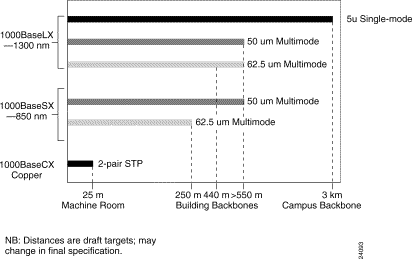
Several means can be used to deploy Gigabit Ethernet to increase bandwidth and capacity within the network. First, Gigabit Ethernet can be used to improve Layer 2 performance. Here, the throughput of Gigabit Ethernet is used to eliminate Layer 2 bottlenecks.
Scaling Bandwidth with Fast EtherChannel and Gigabit EtherChannel
Bandwidth requirements within the network core and between the network core and the wiring closet have placed significant demands on the network. Fast EtherChannel allows multiple Fast Ethernet ports to be bundled together and seen logically by the switches as a fat pipe. Fast EtherChannel allows the bundling of up to four ports, for an aggregate bandwidth of 800 Mbps. With support from NIC manufacturers such as Sun Microsystems, Intel, SGI, Compaq, and Adaptec, Fast EtherChannel can now be provided directly to high-end file servers.
This design provides a scalable switching solution that increases throughput in a router backbone.

Gigabit Ethernet can also be used to aggregate traffic from wiring closets to the network core. Gigabit Ethernet and Gigabit switching are used to aggregate traffic from multiple low-speed switches as a front end to the router. Low-speed switches can be connected either via Fast Ethernet or by a Gigabit Ethernet uplink while the switches provide dedicated 10-Mbps switching or group switching to individual users. The file servers are connected via Gigabit Ethernet for improved throughput performance. Keep in mind that as bandwidth requirements to the core or within the core increase, Gigabit EtherChannel can produce a fourfold increase in performance.
This design demonstrates the use of Gigabit Ethernet switching to improve data center
applications.
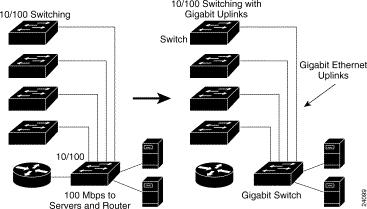
Gigabit Ethernet can also improve Layer 3 performance. This essentially means coupling Layer 2 performance with the benefits of Layer 3 routing. By using the switching paradigm as a road map, Gigabit switching and distributed Layer 3 services can improve the scalability and performance of campus intranets.
The key application of Gigabit Ethernet is expected to be use in the building backbone for interconnection of wiring closets. A Gigabit multilayer switch in the building data center aggregates the building's traffic and provides connection to servers via Gigabit Ethernet or Fast Ethernet. WAN connectivity can be provided by traditional routers or via ATM switching. Gigabit Ethernet can also be used for connecting buildings on the campus to a central multilayer Gigabit switch located at the campus data center. Servers located at the campus data center are also connected to the Gigabit multilayer switch that provides connectivity to the entire campus. Once again, Gigabit EtherChannel can be utilized to significantly increase the bandwidth available within the campus backbone, to high-end wiring closets, or to high-end routers. the figure below illustrates potential multilayer Gigabit switching designs.
This design provides an example of a multilayer Gigabit
switching environment.
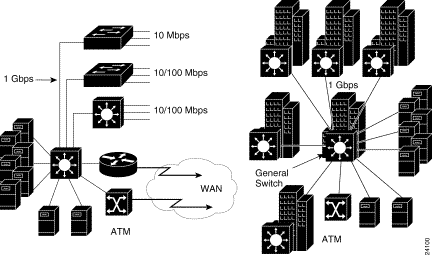
A LAN switch is a device that provides much higher port density at a lower cost than traditional bridges. For this reason, LAN switches can accommodate network designs featuring fewer users per segment, thereby increasing the average available bandwidth per user.
The trend toward fewer users per segment is known as microsegmentation. Microsegmentation allows the creation of private or dedicated segments, that is, one user per segment. Each user receives instant access to the full bandwidth and does not have to contend for available bandwidth with other users. As a result, collisions (a normal phenomenon in shared-medium networks employing hubs) do not occur. A LAN switch forwards frames based on either the frame's Layer 2 address (Layer 2 LAN switch), or in some cases, the frame's Layer 3 address (multi-layer LAN switch). A LAN switch is also called a frame switch because it forwards Layer 2 frames, whereas an ATM switch forwards cells. Although Ethernet LAN switches are most common, Token Ring and FDDI LAN switches are becoming more prevalent as network utilization increases.
The figure below illustrates a LAN switch providing dedicated bandwidth to devices, and it illustrates the relationship of Layer 2 LAN switching to the OSI data link layer:
A LAN switch is a data link layer device.

The earliest LAN switches were developed in 1990. They were Layer 2 devices dedicated to solving bandwidth issues. Recent LAN switches are evolving to multi-layer devices capable of handling protocol issues involved in high-bandwidth applications that historically have been solved by routers. Today, LAN switches are being used to replace hubs in the wiring closet because user applications are demanding greater bandwidth.
LAN switches are similar to transparent bridges in functions such as learning the topology, forwarding, and filtering. These switches also support several new and unique features, such as dedicated communication between devices, multiple simultaneous conversation, full-duplex communication, and media-rate adaption.
Dedicated collision-free communication between network devices increases file-transfer throughput. Multiple simultaneous conversations can occur by forwarding, or switching, several packets at the same time, thereby increasing network capacity by the number of conversations supported. Full-duplex communication effectively doubles the throughput, while with media-rate adaption, the LAN switch can translate between 10 and 100 Mbps, allowing bandwidth to be allocated as needed.
Deploying LAN switches requires no change to existing hubs, network interface cards (NICs), or cabling.
LAN switches can be characterized by the forwarding method they support. In the store-and-forward switching method, error checking is performed and erroneous frames are discarded. With the cut-through switching method, latency is reduced by eliminating error checking.
LAN switches also can be characterized according to the proportion of bandwidth allocated to each port. Symmetric switching provides evenly distributed bandwidth to each port, while asymmetric switching provides unlike, or unequal, bandwidth between some ports.
An asymmetric LAN switch provides switched connections between ports of unlike bandwidths, such as a combination of 10BaseT and 100BaseT. This type of switching is also called 10/100 switching. Asymmetric switching is optimized for client-server traffic flows where multiple clients simultaneously communicate with a server, requiring more bandwidth dedicated to the server port to prevent a bottleneck at that port.
A symmetric switch provides switched connections between ports with the same bandwidth, such as all 10BaseT or all 100BaseT. Symmetric switching is optimized for a reasonably distributed traffic load, such as in a peer-to-peer desktop environment.
A network manager must evaluate the needed amount of bandwidth for connections between devices to accommodate the data flow of network-based applications when deciding to select an asymmetric or symmetric switch.
LAN switches can be categorized according to the OSI layer at which they filter and forward, or switch, frames. These categories are: Layer 2, Layer 2 with Layer 3 features, or multi-layer.
A Layer 2 LAN switch is operationally similar to a multiport bridge but has a much higher capacity and supports many new features, such as full-duplex operation. A Layer 2 LAN switch performs switching and filtering based on the OSI data link layer (Layer 2) MAC address. As with bridges, it is completely transparent to network protocols and user applications.
A Layer 2 LAN switch with Layer 3 features can make switching decisions based on more information than just the Layer 2 MAC address. Such a switch might incorporate some Layer 3 traffic-control features, such as broadcast and multicast traffic management, security through access lists, and IP fragmentation.
A multi-layer switch makes switching and filtering decisions on the basis of OSI data link layer (Layer 2) and OSI network-layer (Layer 3) addresses. This type of switch dynamically decides whether to switch (Layer 2) or route (Layer 3) incoming traffic. A multi-layer LAN switch switches within a workgroup and routes between different workgroups.
Fibre Distributed Data Interface (FDDI)
FDDI is a set of standards origionally designed for MANs, but has since made its way into LANs. FDDI assumes a maximum of 1000 stations and a 200 kilometer path that requires a repeater every 2km.
The Fiber Distributed Data Interface (FDDI) specifies a 100-Mbps token-passing, dual-ring LAN using fiber-optic cable. FDDI is frequently used as high-speed backbone technology because of its support for high bandwidth and greater distances than copper. It should be noted that relatively recently, a related copper specification, called Copper Distributed Data Interface (CDDI) has emerged to provide 100-Mbps service over copper. CDDI is the implementation of FDDI protocols over twisted-pair copper wire.
FDDI uses a dual-ring architecture with traffic on each ring flowing in opposite directions (called counter-rotating). The dual-rings consist of a primary and a secondary ring. During normal operation, the primary ring is used for data transmission, and the secondary ring remains idle. The primary purpose of the dual rings, as will be discussed in detail later in this chapter, is to provide superior reliability and robustness. The figure below shows the counter-rotating primary and secondary FDDI rings.
FDDI uses counter-rotating primary and secondary rings.

FDDI was developed by the American National Standards Institute (ANSI) X3T9.5 standards committee in the mid-1980s. At the time, high-speed engineering workstations were beginning to tax the bandwidth of existing local area networks (LANs) based on Ethernet and Token Ring). A new LAN media was needed that could easily support these workstations and their new distributed applications. At the same time, network reliability had become an increasingly important issue as system managers migrated mission-critical applications from large computers to networks. FDDI was developed to fill these needs. After completing the FDDI specification, ANSI submitted FDDI to the International Organization for Standardization (ISO), which created an international version of FDDI that is completely compatible with the ANSI standard version.
FDDI uses optical fiber as the primary transmission medium, but it also can run over copper cabling. As mentioned earlier, FDDI over copper is referred to as Copper-Distributed Data Interface (CDDI). Optical fiber has several advantages over copper media. In particular, security, reliability, and performance all are enhanced with optical fiber media because fiber does not emit electrical signals. A physical medium that does emit electrical signals (copper) can be tapped and therefore would permit unauthorized access to the data that is transiting the medium. In addition, fiber is immune to electrical interference from radio frequency interference (RFI) and electromagnetic interference (EMI). Fiber historically has supported much higher bandwidth (throughput potential) than copper, although recent technological advances have made copper capable of transmitting at 100 Mbps. Finally, FDDI allows two kilometers between stations using multi-mode fiber, and even longer distances using a single mode.
FDDI specifies the physical and media-access portions of the OSI reference model. FDDI is not actually a single specification, but it is a collection of four separate specifications each with a specific function. Combined, these specifications have the capability to provide high-speed connectivity between upper-layer protocols such as TCP/IP and IPX, and media such as fiber-optic cabling.
FDDI is similar to IEEE 802.3 Ethernet and IEEE 802.5 Token Ring in its relationship with the OSI model. Its primary purpose is to provide connectivity between upper OSI layers of common protocols and the media used to connect network devices.
One of the unique characteristics of FDDI is that multiple ways actually exist by which to connect FDDI devices. FDDI defines three types of devices: single-attachment station (SAS), dual-attachment station (DAS), and a concentrator.
An SAS attaches to only one ring (the primary) through a concentrator. One of the primary advantages of connecting devices with SAS attachments is that the devices will not have any effect on the FDDI ring if they are disconnected or powered off. Concentrators will be discussed in more detail in the following discussion.
Each FDDI DAS has two ports, designated A and B. These ports connect the DAS to the dual FDDI ring. Therefore, each port provides a connection for both the primary and the secondary ring. As you will see in the next section, devices using DAS connections will affect the ring if they are disconnected or powered off. The figure below shows FDDI DAS A and B ports with attachments to the primary and secondary rings.
FDDI DAS ports attach to the primary and secondary rings.
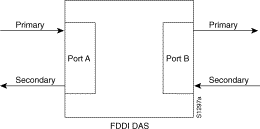
An FDDI concentrator (also called a dual-attachment concentrator [DAC]) is the building block of an FDDI network. It attaches directly to both the primary and secondary rings and ensures that the failure or power-down of any SAS does not bring down the ring. This is particularly useful when PCs, or similar devices that are frequently powered on and off, connect to the ring. The figure below shows the ring attachments of an FDDI SAS, DAS, and concentrator.
A concentrator attaches to both the primary and secondary rings.
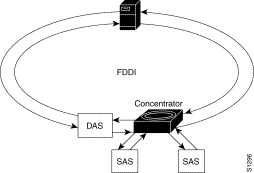
The FDDI frame format is similar to the format of a Token Ring frame. This is one of the areas where FDDI borrows heavily from earlier LAN technologies, such as Token Ring. FDDI frames can be as large as 4,500 bytes.The figure below shows the frame format of an FDDI data frame and token.
The FDDI frame is similar to that of a Token Ring frame.
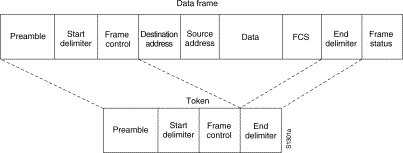
The following descriptions summarize the FDDI data frame and token fields illustrated above.
Copper Distributed Data Interface (CDDI) is the implementation of FDDI protocols over twisted-pair copper wire. Like FDDI, CDDI provides data rates of 100 Mbps and uses a dual-ring architecture to provide redundancy. CDDI supports distances of about 100 meters from desktop to concentrator.
The ANSI standard recognizes only two types of cables for CDDI: shielded twisted pair (STP) and unshielded twisted pair (UTP). STP cabling has a 150-ohm impedance and adheres to EIA/TIA 568 (IBM Type 1) specifications. UTP is data-grade cabling (Category 5) consisting of four unshielded pairs using tight-pair twists and specially developed insulating polymers in plastic jackets adhering to EIA/TIA 568B specifications.
FDDI-II
FDDI-II permits the transmission of voice and video over the same cable as the normal FDDI token passing data. FDDI-II functions like FDDI, but adds the ability to divide the the 100Mbps circuit between the FDDI token-passing data circuit and one or more circuit switched circuits for voice and/or video. FDDI uses TDM to break the 100Mbps second channel into 17 seperate channels (one 768Kbps and 16 6.144 Mbps wide band channels. The 786Kbps channel is dedicated to data, while the other channels can be either token passing data circuits or connection orientated virtual circuits used for the transmission of voice and/or video.